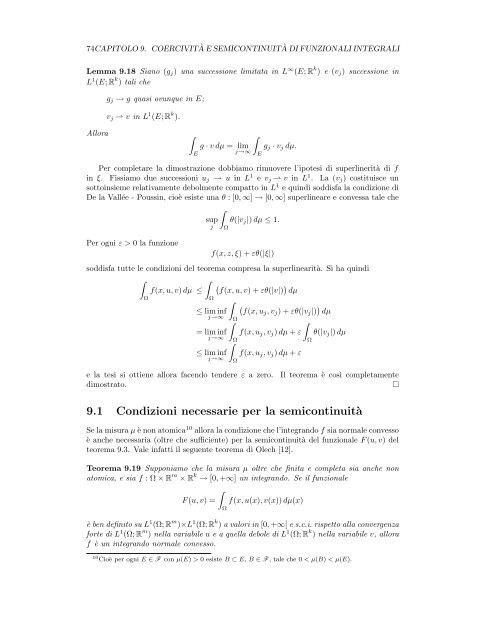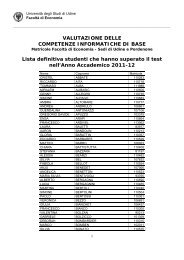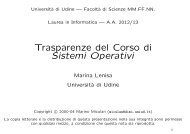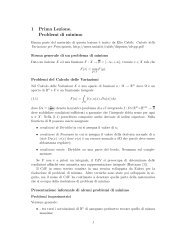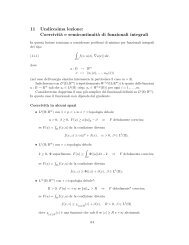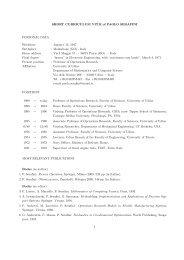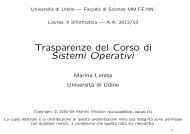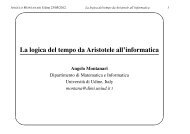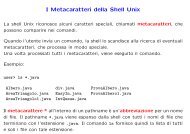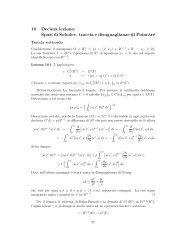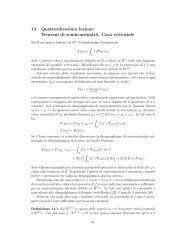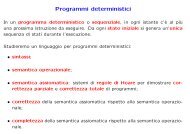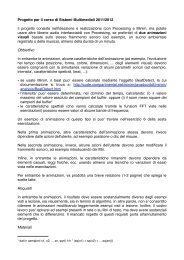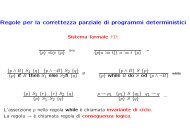Capitolo 9 - Dipartimento di Matematica e Informatica
Capitolo 9 - Dipartimento di Matematica e Informatica
Capitolo 9 - Dipartimento di Matematica e Informatica
Create successful ePaper yourself
Turn your PDF publications into a flip-book with our unique Google optimized e-Paper software.
74CAPITOLO 9. COERCIVITÀ E SEMICONTINUITÀ DI FUNZIONALI INTEGRALI<br />
Lemma 9.18 Siano (gj) una successione limitata in L ∞ (E; R k ) e (vj) successione in<br />
L 1 (E; R k ) tali che<br />
gj → g quasi ovunque in E;<br />
vj ⇀ v in L 1 (E; R k ).<br />
Allora <br />
E<br />
<br />
g · v dµ = lim gj · vj dµ.<br />
j→∞<br />
E<br />
Per completare la <strong>di</strong>mostrazione dobbiamo rimuovere l’ipotesi <strong>di</strong> superlinerità <strong>di</strong> f<br />
in ξ. Fissiamo due successioni uj → u in L1 e vj ⇀ v in L1 . La (vj) costituisce un<br />
sottoinsieme relativamente debolmente compatto in L1 e quin<strong>di</strong> sod<strong>di</strong>sfa la con<strong>di</strong>zione <strong>di</strong><br />
De la Vallée - Poussin, cioè esiste una θ : [0, ∞] → [0, ∞] superlineare e convessa tale che<br />
<br />
sup θ(|vj|) dµ ≤ 1.<br />
j Ω<br />
Per ogni ε > 0 la funzione<br />
f(x, z, ξ) + εθ(|ξ|)<br />
sod<strong>di</strong>sfa tutte le con<strong>di</strong>zioni del teorema compresa la superlinearità. Si ha quin<strong>di</strong><br />
<br />
<br />
f(x, u, v) dµ ≤<br />
<br />
f(x, u, v) + εθ(|v|) dµ<br />
Ω<br />
Ω <br />
<br />
≤ lim inf f(x, uj, vj) + εθ(|vj|)<br />
j→∞<br />
Ω<br />
dµ<br />
<br />
<br />
= lim inf f(x, uj, vj) dµ + ε<br />
j→∞<br />
Ω<br />
θ(|vj|) dµ<br />
Ω<br />
≤ lim inf<br />
j→∞<br />
f(x, uj, vj) dµ + ε<br />
Ω<br />
e la tesi si ottiene allora facendo tendere ε a zero. Il teorema è così completamente<br />
<strong>di</strong>mostrato. <br />
9.1 Con<strong>di</strong>zioni necessarie per la semicontinuità<br />
Se la misura µ è non atomica 10 allora la con<strong>di</strong>zione che l’integrando f sia normale convesso<br />
è anche necessaria (oltre che sufficiente) per la semicontinuità del funzionale F (u, v) del<br />
teorema 9.3. Vale infatti il seguente teorema <strong>di</strong> Olech [12].<br />
Teorema 9.19 Supponiamo che la misura µ oltre che finita e completa sia anche non<br />
atomica, e sia f : Ω × R m × R k → [0, +∞] un integrando. Se il funzionale<br />
<br />
F (u, v) = f(x, u(x), v(x)) dµ(x)<br />
Ω<br />
è ben definito su L 1 (Ω; R m )×L 1 (Ω; R k ) a valori in [0, +∞[ e s.c.i. rispetto alla convergenza<br />
forte <strong>di</strong> L 1 (Ω; R m ) nella variabile u e a quella debole <strong>di</strong> L 1 (Ω; R k ) nella variabile v, allora<br />
f è un integrando normale convesso.<br />
10 Cioè per ogni E ∈ F con µ(E) > 0 esiste B ⊂ E, B ∈ F , tale che 0 < µ(B) < µ(E).


